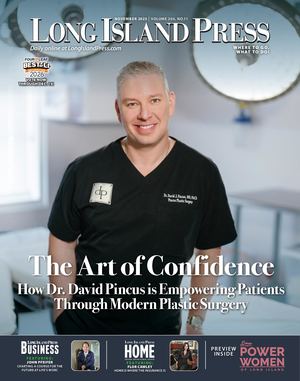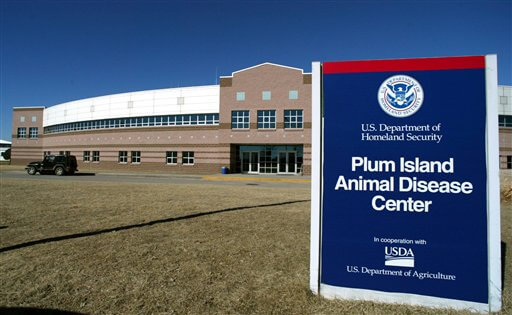
Just off the southeast shore of Plum Island last week, a dozen or so harbor seals perched in poses mimicking phases of the moon on sea-weathered rocks, while others poked heads out of the dark waters, all turning toward the low, sandy cliff along the beach to a small group gathered on the flat meadow above.
Between the seals watching the people and the people watching the seals stood a row of large signs with some unequivocal messages: “U.S. Property. No Trespassing,” and “Landing Prohibited.”
Even the seals, which congregate around the island in the hundreds during the peak months of winter and early spring, seem to understand that Plum Island, in its current incarnation, isn’t a place open for free-frolicking by large mammals of any sort. The seals, despite their curiosity about humans, oddly never seem to haul themselves onshore here, even though that’s their habit on other Long Island Sound beaches.
That observation about the island’s seal population, made by one of the security guards of the U.S. Department of Homeland Security property in eastern Long Island Sound, came during a tour last week provided by homeland security officials in advance of public hearings this week about the island’s future.
Natural areas of the 840-acre island, from the undeveloped beaches to the meadows alive with wildflowers, songbirds and migrating monarchs, were a main focus of the tour, as they have been a main focus of conservation groups lobbying to preserve the island if the plans for its sale by the federal government are realized.
The tour, however, also acquainted visitors with the island’s past and current role in protecting the nation. Connected by narrow dirt roads, a collection of empty red brick and concrete structures that served as soldiers’ barracks, gun batteries and training quarters are interspersed between meadows and shrubby fields, remnants of Fort Terry.
The Army installation, built for the Spanish-American War, operated through the early 1950s, when the island was turned over to the U.S. Department of Agriculture for animal disease research.
Now, federal government plans call for the island’s 58-year history in animal disease research to come to a close over the next decade. An as-yet unfunded plan exists for a $1.4 billion lab to be built in Manhattan, Kan., by 2021. Yet even as preliminary preparations for a bigger, better replacement for the Plum Island labs continue, its scientists still want the story of the work they do there daily – and will continue to do for the foreseeable future – to be better known and understood by the public.
“This lab is not a threat to the nation. This lab is here to protect the nation,” said Larry Barrett, director of the Plum Island Animal Disease Center.
Every time Americans go to the grocery store or enjoy a hamburger, ham sandwich, glass of milk or the myriad food products that contain beef, dairy and pork ingredients, they can thank the Plum Island labs, he said. Without the research and diagnostic work Plum Island scientists have done into cattle and swine diseases and their antidotes, he contends, U.S. food prices would be much higher and the nation’s farm economy far weaker.
“Farming and agriculture is a trillion-dollar industry. It’s our food supply and 16 percent of the economy, and livestock are a critical component of that,” he said.
An outbreak of foot-and-mouth disease, a main focus of the Plum Island lab since it opened, would deal a $50 billion, four-year blow to the U.S. economy, Barrett said. Even though the disease has not appeared in this country since 1929, it remains active in other parts of the world. Like the human influenza virus, foot-and-mouth is a highly changeable pathogen with multiple strains circulating at any one time. It is also deadly and highly contagious among cattle, carried easily on the wind.
“Foot-and-mouth is so complex, it’s kept many people busy for many years, and we still have a lot to do,” said Luis Rodriguez, an Old Saybrook resident and research leader for the foreign animal disease research unit of the USDA. “It’s unpredictable and can show up anywhere at any time.”
Just two years ago, he noted, Plum Island researchers unraveled the mechanism the virus uses to infect cattle. It enters through the respiratory system and then enters the bloodstream, so by the time the telltale sores are visible, the disease is full-blown.
Additional contributions of Plum Island scientists, Barrett said, include development of a significant new foot-and-mouth vaccine announced in June. They also help keep the nation’s state and federal veterinarians up-to-date with regular training programs on the island, and share advances with colleagues worldwide in understanding how animals are sickened with foot-and-mouth and other diseases like African swine fever and common swine fever, Barrett said. Without this work, he said, this country surely would surely have had a foot-and-mouth outbreak far worse than the once experienced in England in 2001, or the one in Japan in 2010, which caused $6 billion and $4 billion in losses, respectively.
The labs at Plum Island consist of two areas, one with a higher security level, housed along with offices and a cafeteria in a comfortable 1993 building adjacent to warehouses where livestock used in tests and experiments are kept. The entire center, which occupies about 25 acres of the island, is enclosed by barbed wire fencing.
Overseeing the labs is Director of Science Bruce Harper, an Old Saybrook resident.
“This is one of the rooms where we do tissue cultures,” said Harper, showing an area with hooded lab tables and other equipment.
That morning, he explained, scientists had been in the lower-security, or Level 2, lab, working on a project to shorten the time it takes for the new foot-and-mouth vaccine developed at Plum Island to become protective to animals by incorporating interferon into it.
“We’re trying to get it to one or two days,” he said, adding that with the existing vaccine, cattle take 12 days to develop antibodies against the virus.
He led visitors through the lab, past centrifuges, protective gowns hanging on racks, an autoclave for instrument sterilization and medical waste collection bins, all idle just after lunchtime that day. The lab, he explained, had been busy in the morning, but researchers had come to a point when they needed to enter the higher-level security lab to complete their work. Now, he said, they were behind a door in an inner lab-within-a-lab where special access and decontamination procedures must be followed.
Barrett and his fellow scientists describe an impressive track record of advances in vaccine and animal disease research made at Plum Island over the years, published regularly in scientific journals and reports available to the scientific community and the public. Yet the island, owing to the security measures necessary to prevent any accidental or intentional release of live, dangerous viruses, remains the subject of myths and conspiracy theories about what’s really going on there, Barrett admits.
The often-repeated speculation that Lyme disease is the result of Plum Island research gone bad, for example, would be impossible, he said. No research is done at the island on any diseases that can be transmitted from animals to humans, including vector-borne illnesses carried by ticks and mosquitoes. A need for a higher-security facility that can research diseases that can jump the human-animal barrier is, in fact, the rationale used for building a lab to replace Plum Island.
Then there’s the 2008 incident known as the Montauk monster, in which a corpse of an unidentified animal washed up on a Long Island beach and caused some wild rumors to begin circulating that the animal had its origins in the Plum Island labs. Appearing in a History Channel show on the case, Barrett, a veterinarian, cleared up the mystery by using his knowledge of canine anatomy. As the cameras rolled, he recalled, he superimposed a picture of the skeleton of a boxer on a photo of the partially decayed carcass, and the two matched perfectly.
“I’ve given testimony in Congress, I’ve been on C-SPAN, and then I’ve been on ‘Monster Quest,'” he joked, using the name of the History Channel Show.
Barrett said that in the past few years, the center has been reaching out to the public by inviting more groups to tour the island, hoping to give people some firsthand knowledge to counter the speculation.
“We’ve been having about 15 groups a year, about 500 people total,” he said. “We get them to tour the lab and see the island. We’ve had Boy Scouts, Girl Scouts, high school groups, community groups, and we’re hoping to build on that further.”
About 360 people work on the island, taking the ferry daily from Old Saybrook or Orient Point on Long Island, but only about 60 of those are scientists directly involved in the research. Support and security staff make up the rest, a reflection of the complexities of operating a highly technical lab with enclosed barns for livestock, its own power supply and wastewater treatment plants, on an island.
“It’s not a huge team of scientists here, so we have to be very focused on what we do,” said Rodriguez.
Copyright 2012 The Associated Press.



































